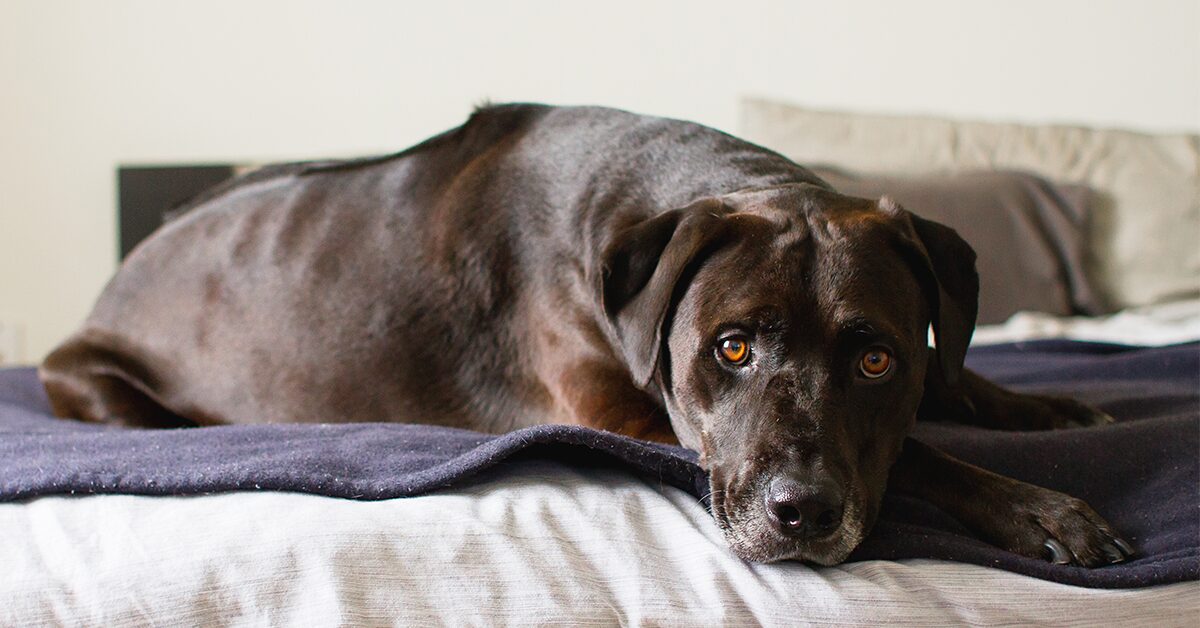If you think your dog is showing signs of anxiety, you’re not alone.
It’s not uncommon for different environments, people, or even objects to trigger anxiety in dogs. If you find that your dog is acting out of the ordinary – perhaps incessantly trembling, panting, whining, or pacing – they may be experiencing nervousness or anxiety.
We’re here to help you identify what is triggering your dog’s anxiety and how to restore a sense of calm.
What is anxiety in dogs?
Nervousness and anxiety are two different issues. Knowing the difference can help you identify the reasons behind your dog’s distress and solve it.
Nervousness is a temporary, low-intensity anticipation of an imagined or future threat. Your dog may bark and whine when you pick up your car keys, but once you leave, they will calm down. Their distress is short-lived and they can go about their day.
Anxiety is a more intense anticipation of that threat. That same dog may begin whining and barking, pacing, and showing more extreme physical responses in anticipation of your leaving. Once you’ve left, the dog will continue to whine, pace, pant, bark, and may even display destructive behavior patterns such as chewing furniture or urinating and pooping in the house.
How to recognize your dog’s anxiety
There can be many triggers and causes of anxiety in dogs. From lack of proper socialization in puppyhood, to abandonment or abuse, to cognitive decline in older dogs – there can be many underlying reasons for your dog’s anxiety.
It’s always a good idea visit your vet first and rule out any illness or injury as a cause first. If your dog is healthy, but has anxiety, taking note of their individual signs of anxiety or fear as well as the circumstances they’re in when symptoms strike can help you get to the bottom of it.
Signs of anxiety
- Shaking or trembling
- Dilated pupils
- Pacing
- Rapid panting and increased heart rate
- Lip licking
- Frequent yawning
- Loss of appetite
- Hyper-alert to surroundings
- Drooling
- Pooping or peeing in the house
- Over-grooming or constant licking of fur on legs or feet (self trauma)
- Destructive behavior or aggression
- Extreme escape attempts (breaking out of crates or chewing and pawing through doors and windows)
Common anxiety triggers in dogs
Separation anxiety is the most common cause of anxiety in dogs. But there are other triggers that can cause fear as well.
- Loud noise: Thunderstorms, lightning, fireworks, gunfire, yelling, and very loud music can send your dog into extreme distress.
- Travel: Car rides, or traveling by air, can be frightening with scenery rushing by and loud engine noises.
- People: Dogs can have preferences for gender, or be afraid of small children and even adults. Many dogs can fear strangers of any size or demeanor.
- Other animals: The presence of other dogs or wild animals can trigger fear, even at the dog park.
- Genetics: Some dog breeds are more prone to anxiety. Breeds like Labrador Retrievers, Bernese Mountain Dogs, Poodles, Cavalier King Charles Spaniel, and German Shepherds are more likely to experience anxiety.
- Rescue or Shelter: Unfamiliar sights, sounds, and smells can traumatize dogs in shelters and rescues.
- Vets & Groomers: Both can be a cause for the anticipation of a threat for your dog.
- Social and Environmental stressors: New places, people, and animals can be an enormous source of stress when dogs haven’t received proper socialization when very young.
Once you figure out what is triggering your dog, and can recognize your dog’s body language, solving the anxiety can take many forms. You can solve extreme anxiety with a combination of a veterinarian, medicine, and a Certified Veterinary Behaviorist. You’ll still need to remove triggers, but a combo of counter-conditioning, desensitization and anxiety medications may be needed.
Pet Pro Tip: Illnesses won’t wait to happen. You shouldn’t wait to enroll in pet insurance. From common parasite infections, to costly hereditary illnesses, pet insurance is worth it and can cover crucial eligible treatment your pet may need for their unexpected accidents and illnesses. Find out how pet insurance works, what pet insurance covers, and choose a plan today.
Ways to reduce anxiety in dogs
- Eliminate triggers: Find and remove or avoid triggers that set your dog into bouts of anxiety.
- Exercise: A well-exercised dog is less likely to become anxious and display destructive behavior patterns. Physical exercise and mental stimulation calms your dog’s nervous system.
- Create a sanctuary: A cozy crate or corner of your home that your dog can go to relax can help calm them down. Crate training can help your dog understand their crate is a quiet safe space to calm down.
“You might feel inclined to give your dog a reassuring hug in stressful situations, but this isn’t always a good tactic. If you are petting and loving on your dog after a negative reaction, you are rewarding their anxiety. The best move is to ignore them until they figure out that the stimulus is nothing to worry about.”
Richard Lovejoy, Professional Dog Trainer
- Pheromones: Put a pheromone diffuser in the room your dog spends the most time in. The pheromones mimic those given off by nursing moms to calm their pups.
- Distraction: Your dog’s favorite chews or toys can distract them from the noise or fear inducing trigger. My dogs will be very distracted and calm down with a good bully stick. The chewing action is also calming and helps them relax. Food dispensing toys works well as well.
- Music or white noise: Dogs prefer classical music, but any soft music or white noise machine will calm your nervous dog down.
- Behavior modification: Your vet, an animal behaviorist, or a professional dog trainer can work your dog through these behavior problems.
- Counter-conditioning, or teaching your dog to ignore a specific trigger for a tasty treat or something else your dog loves. Basically, learning to associate positive reward to a negative stimulus.
- Desensitization, or exposing your dog to a low-key version of a trigger and rewarding calm behavior. Your dog learns to associate the trigger with something positive.
- Anxiety medications like Adaptil, Prozac, and Trazadone are all veterinary medications that can help your dog with anxiety without putting them into a stupor.
- Calming supplements: Supplements like Rescue Remedy, Calming Care, or Calm Shen may help with nervousness or less severe anxiety and designed for long-term use.
- Calming dog treats like July Third, Calming Bites, and Composure that contain melatonin, lavender, valerian, chamomile, and other calming herbs are helpful for temporary bouts of anxiety and are quick acting.
- CBD treats made from industrial hemp (high CBD, no THC) like Hemp Calming Chews are effective for calming dogs quickly.
- Calming coats that use swaddling-like pressure to calm your dog, like a big hug. The Thundershirt has been around for years and has proven to be very effective at calming dogs with anxiety. Both my dogs wear them during fireworks to remain calm..
Learning what triggers your dog’s anxiety can lead you to a resolution and allow you to keep you and your furry friend happy. If behavioral health visits are needed to get to the bottom of your dog’s anxiety, pet insurance can help with costs associated with visits and treatment to help your pooch get the best care possible.




